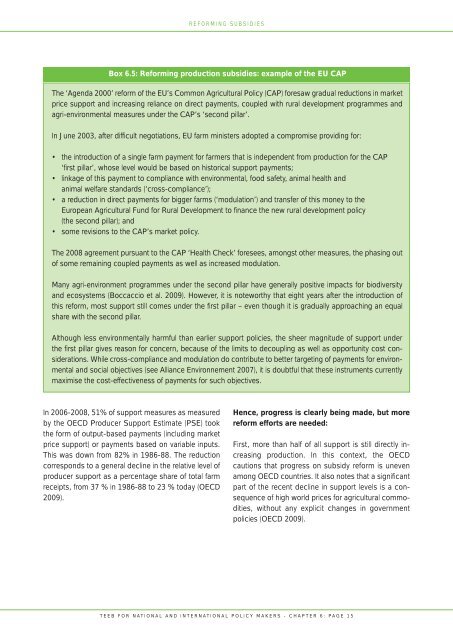Download (PDF, 6.71MB) - TEEB
Download (PDF, 6.71MB) - TEEB
Download (PDF, 6.71MB) - TEEB
You also want an ePaper? Increase the reach of your titles
YUMPU automatically turns print PDFs into web optimized ePapers that Google loves.
In 2006-2008, 51% of support measures as measured<br />
by the OECD Producer Support Estimate (PSE) took<br />
the form of output-based payments (including market<br />
price support) or payments based on variable inputs.<br />
This was down from 82% in 1986-88. The reduction<br />
corresponds to a general decline in the relative level of<br />
producer support as a percentage share of total farm<br />
receipts, from 37 % in 1986-88 to 23 % today (OECD<br />
2009).<br />
REFORMING SUBSIDIES<br />
Box 6.5: Reforming production subsidies: example of the EU CAP<br />
The ‘Agenda 2000’ reform of the EU’s Common Agricultural Policy (CAP) foresaw gradual reductions in market<br />
price support and increasing reliance on direct payments, coupled with rural development programmes and<br />
agri-environmental measures under the CAP’s ‘second pillar’.<br />
In June 2003, after difficult negotiations, EU farm ministers adopted a compromise providing for:<br />
• the introduction of a single farm payment for farmers that is independent from production for the CAP<br />
‘first pillar’, whose level would be based on historical support payments;<br />
• linkage of this payment to compliance with environmental, food safety, animal health and<br />
animal welfare standards (‘cross-compliance’);<br />
• a reduction in direct payments for bigger farms (‘modulation’) and transfer of this money to the<br />
European Agricultural Fund for Rural Development to finance the new rural development policy<br />
(the second pillar); and<br />
• some revisions to the CAP’s market policy.<br />
The 2008 agreement pursuant to the CAP ‘Health Check’ foresees, amongst other measures, the phasing out<br />
of some remaining coupled payments as well as increased modulation.<br />
Many agri-environment programmes under the second pillar have generally positive impacts for biodiversity<br />
and ecosystems (Boccaccio et al. 2009). However, it is noteworthy that eight years after the introduction of<br />
this reform, most support still comes under the first pillar – even though it is gradually approaching an equal<br />
share with the second pillar.<br />
Although less environmentally harmful than earlier support policies, the sheer magnitude of support under<br />
the first pillar gives reason for concern, because of the limits to decoupling as well as opportunity cost considerations.<br />
While cross-compliance and modulation do contribute to better targeting of payments for environmental<br />
and social objectives (see Alliance Environnement 2007), it is doubtful that these instruments currently<br />
maximise the cost-effectiveness of payments for such objectives.<br />
Hence, progress is clearly being made, but more<br />
reform efforts are needed:<br />
First, more than half of all support is still directly increasing<br />
production. In this context, the OECD<br />
cautions that progress on subsidy reform is uneven<br />
among OECD countries. It also notes that a significant<br />
part of the recent decline in support levels is a consequence<br />
of high world prices for agricultural commodities,<br />
without any explicit changes in government<br />
policies (OECD 2009).<br />
<strong>TEEB</strong> FOR NATIONAL AND INTERNATIONAL POLICY MAKERS - CHAPTER 6: PAGE 15

















